The ultimate purpose of a battleship is to carry guns. Everything else - armor, engines, living quarters - ultimately exists to support the delivery of high-velocity steel to the enemy. As such, it’s a topic which deserves a close look.
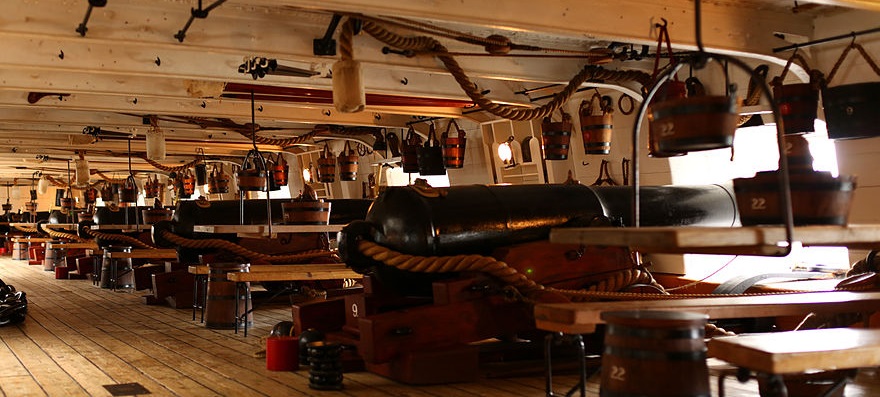
The gun deck of HMS Warrior
As you probably expect by now, we’ll start with HMS Warrior. She carried a total of 40 guns: 26 68-pounder smoothbore muzzle-loaders, 10 110-pounder rifled breech-loaders,1 and 4 40-pounder rifled breech-loaders.
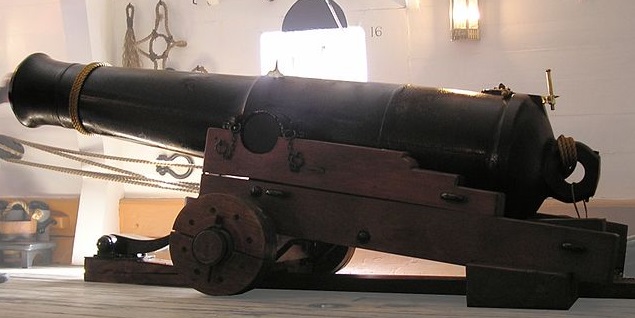
68-pounder replica aboard Warrior
Odd though it may seem, the best of these guns were the 68-pounders, firing 8″ iron shot. The last and largest of a long line of British cast-iron smoothbores, these guns had developed a formidable reputation, most famously in battering the walls of Sevastopol. They were the only weapons capable of penetrating the 4.5″ armor of Glorie, and the original plan had been to arm Warrior with 42 of them. However, the development of the Armstrong breechloaders caused these plans to be revised, with some of the 68-pounders replaced.
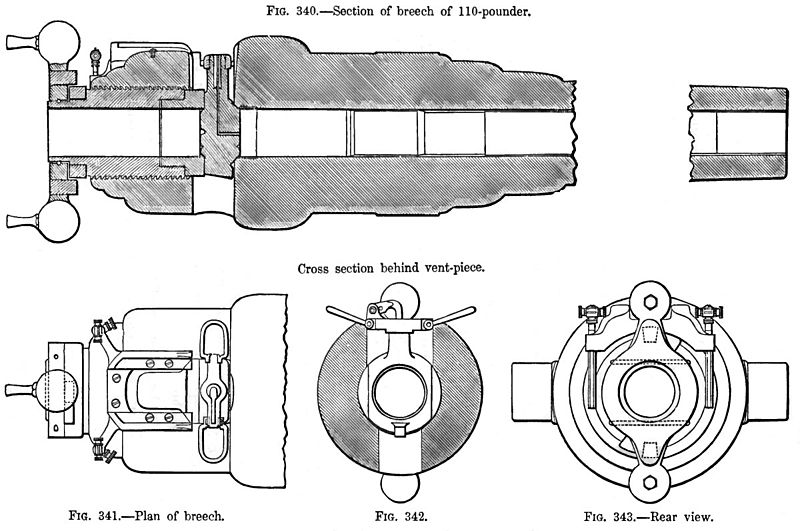
Diagram of 110-pounder breech mechanism
Unfortunately, while the Armstrong guns were a definite step forward technologically, they were a step backwards from an operational standpoint. Even on a good day, the 110-pounder was not as effective as the 68-pounder at piercing armor,2 and there were many bad days. To load the gun, the large, hollow screw at the breech was loosened, and the block it secured lifted out. The gun was loaded through the center of the screw, and the block replaced. The problem was that the crew simply tightened the screw as much as they could, and there was no positive closed position. It’s usually claimed that 21 Armstrong Guns suffered 28 accidents in the course of firing only 365 rounds during the bombardment of Kagoshima, but this doesn’t look to be true.3 In any case, the gun was not a success, and was swiftly relegated to coastal defense duties.
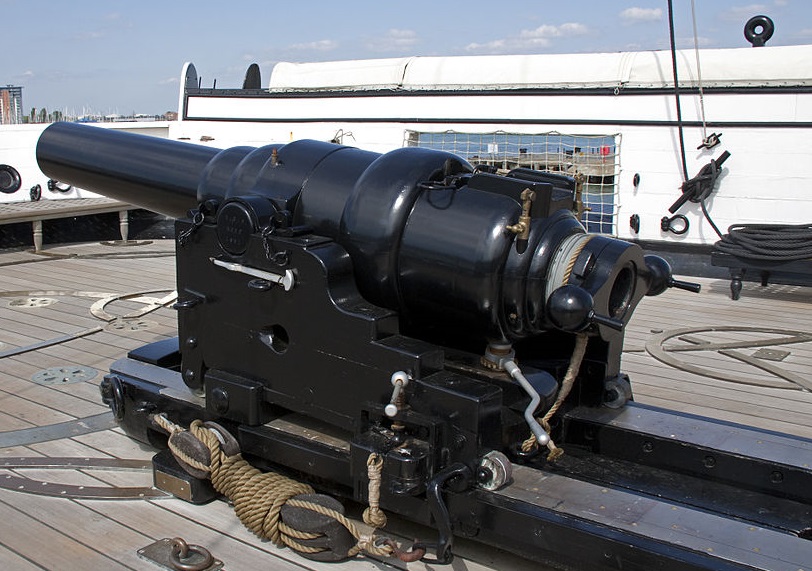
110-pounder on a pivoting slide mount on Warrior’s deck.
Most of Warrior’s guns were mounted much like guns had been for centuries, on wheeled carriages secured with rope to absorb the recoil.4 They were run in and out by their crews, much as had been done in Nelson’s day. The gunports were narrower than normal, and the guns pivoted around a bolt in the sill instead of further back. However, the ports were taller than was normal on a battleship, to allow Warrior to fight at long range. The gun was supported in the carriage by a pair of cylinders on either side called trunions, and wedges were used to raise and lower the muzzle.
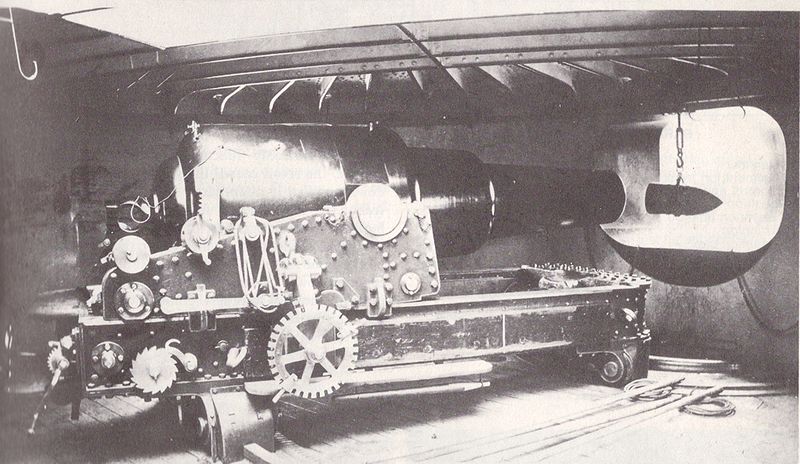
12″ RML on HMS Hotspur
The failure of the Armstrongs soured the RN on breech-loaders, but the drive for improvement over the smoothbores was still there, and the Rifled Muzzle-Loader (RML) was the result. This gun was built around a steel tube, with wrought iron tubes wrapped around it for greater strength. The shell had studs on the side, which engaged the grooves in the barrel. The resulting gun was cheap and safe, but not particularly effective. It was introduced starting in the mid-1860s, and was made in sizes ranging from 6″ up to the massive 16″ guns used on HMS Inflexible.
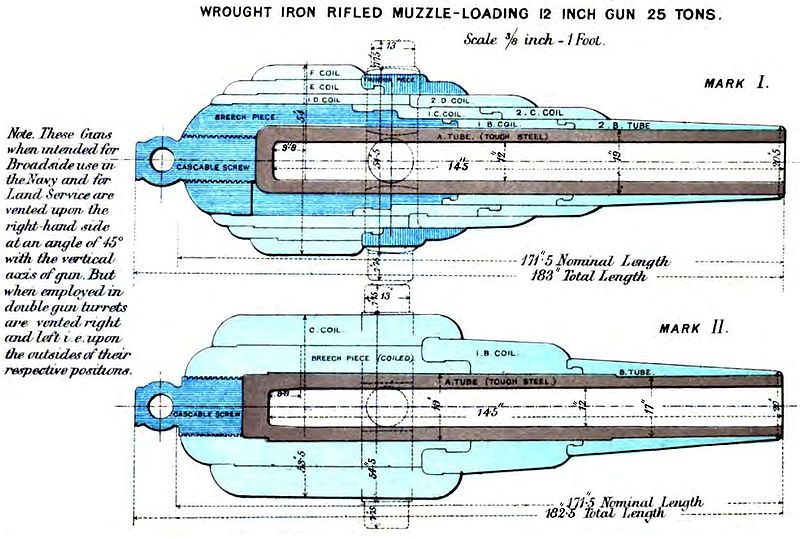
Construction diagram of RML 12″ 25-ton gun
The gun’s shape, much thicker on the breech end, was a result of the powder at the time. Black powder burns quickly, which means that for a given muzzle velocity, the pressure at the breech must be high, tapering off quickly as the projectile moves down the barrel. Projectiles improved in parallel with guns, as the balls of previous guns were replaced by elongated shot and shells. The first major innovation was Palliser shot, made of cast iron and chilled to give it reasonable armor-piercing capability.5
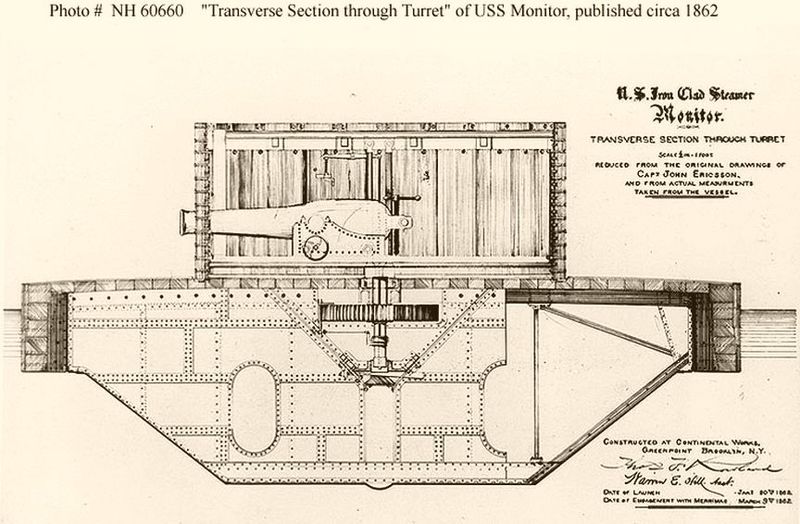
Ericsson turret of Monitor
There was also significant innovation in the field of mountings. Even while Warrior was under construction, inventors on both sides of the Atlantic had decided that it would be better to mount guns in a rotating structure on top of a ship. This became known as a turret, by analogy to the turrets of castles. John Ericsson’s turret, used on the famous Monitor, rested on a central spindle, which had to be lifted when the turret turned. The turret developed by Cowper Coles in the UK used a roller path below deck instead. In the end, the Coles turret won out, as it scaled better to heavier turrets and was always ready to fire.6
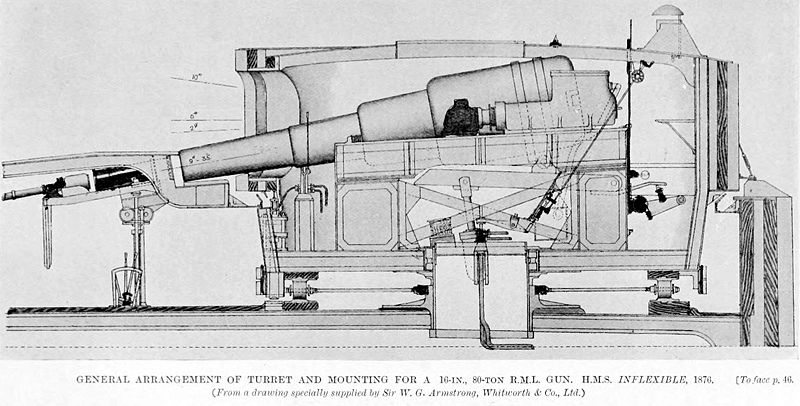
Coles turret of HMS Inflexible, showing external loading mechanism7
While it might seem intuitively obvious that the turret would kill off the muzzle-loader, this was not in the case. In fact, external loading mechanisms meant that muzzle-loaders actually required a smaller, simpler turret than breech-loaders. The rammer was mounted under the deck, and the turret was trained and depressed to bring it into line with the rammer. This meant that ammunition didn’t have to be passed into the turret, either. Initially, loading and ramming was done by hand, but in the mid-1870s, power operation was used.8 Hydraulic recoil mechanisms were also introduced, more effective and faster to work than simply having the weapon slide across the deck with friction and ropes to slow it down.
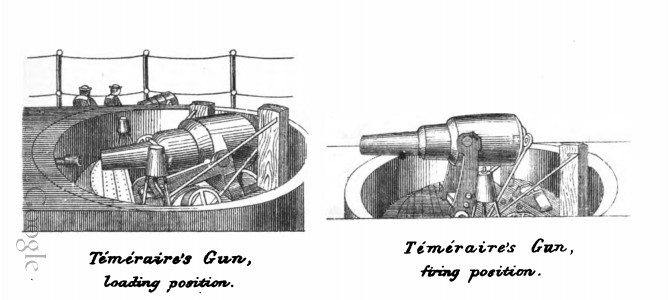
Disappearing gun barbette on HMS Temeraire
The main alternative to the turret was the barbette. This was a tub mounted on the upper deck, which the guns retracted into to load. With the slow-firing guns of the day, the open-topped barbette was considered sufficient protection, although some nations mounted light hoods over theirs to provide protection from small-arms fire and quick-firing guns.
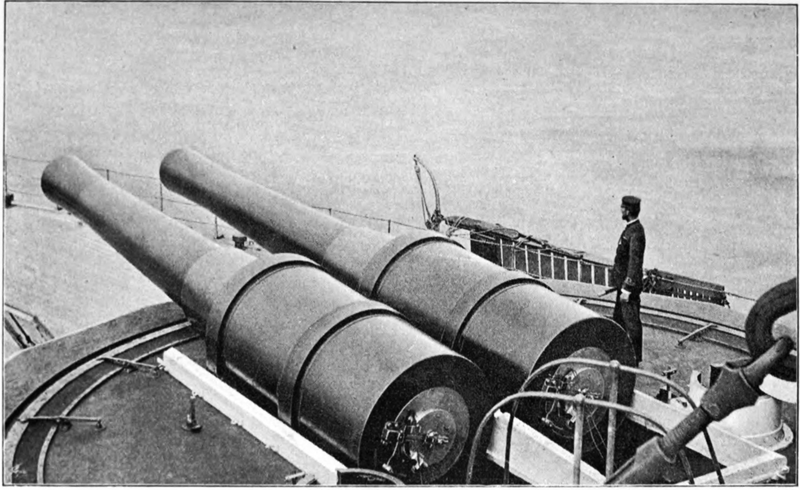
BL 13.5″ guns in a barbette mount
What ultimately killed off the muzzle-loader was improved powder. The new powder, called brown powder, burned more slowly than black powder. This let guns reach a higher muzzle velocity, but required longer barrels, which couldn’t be loaded from the muzzle. Typical RMLs were 12-13 calibers9 long, while the first BL guns were 25 calibers. There was a corresponding rise in muzzle velocity from 400-420 m/s to 580 m/s for the 12″ guns.
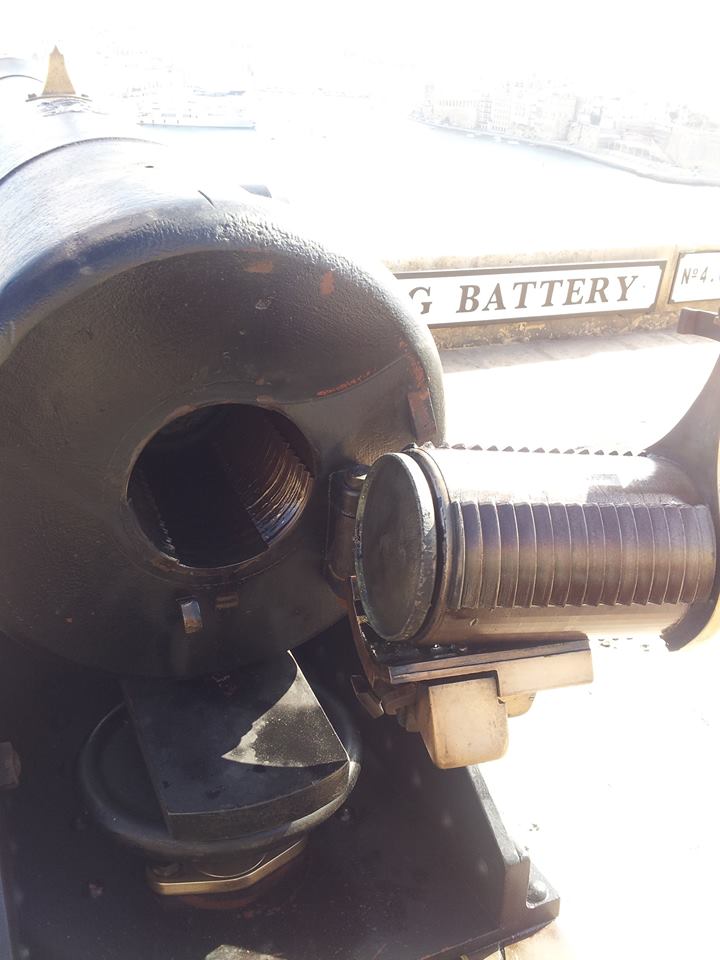
An interrupted-screw breechblock and breech10
Over the intervening years, the problems of sealing the breech had also been solved. Instead of a removable block and a separate screw, the block itself was now locked into the breech with an interrupted screw, which was usually in 5 or 6 segments. This meant that the screw only had to be turned through 30 or 36 degrees to lock it, although the block had to be fairly deep to provide sufficient bearing surface to hold it against the powder. To stop gas from leaking around the edges, a device called an obdurator was used. When the gun was fired, the pressure pushed mushroom-shaped obdurator back, forcing the asbestos washer to seal the breech. The system, invented by Charles Ragon de Bange, is still in use today.
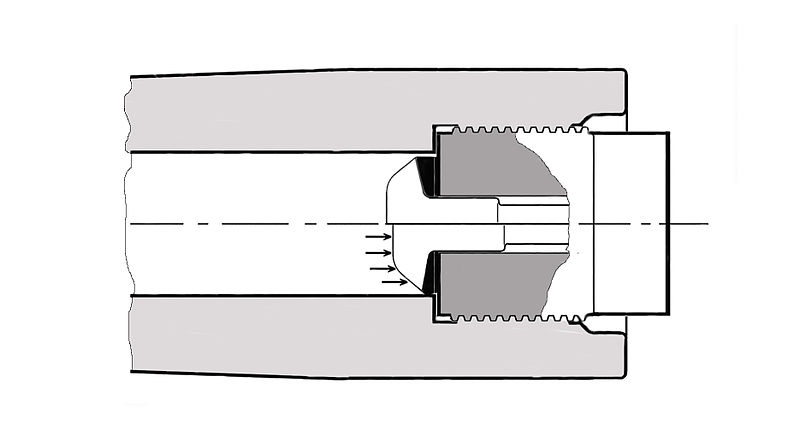
The de Bange system of obduration
By the 1880s, naval guns had come a long way from those mounted on Warrior, but there was still a long way to go before ships like Dreadnought became practical. We’ll discuss that transition next time.
Anyone who wants more details on the early breechloaders should check out Rob Brassington’s incredible breakdown of HMS Colossus.
1 For those who don’t know, rifling is when a gun’s barrel is cut with grooves to spin the projectile, improving accuracy. Muzzle-loaders have the projectile and powder inserted from the front, and pushed down the barrel. Breech-loaders have the back of the gun opened up and the shell and powder inserted. ⇑
2 The 110-pdr threw its projectile at 340 m/s, while the 68-pdr hit 480 m/s. The 68-pdr ball had about 25% more kinetic energy, which is a not entirely terrible way of measuring armor penetration. ⇑
3 Thanks to commenter 67th Tigers for bringing this to my attention. ⇑
4 A few, such as the one above, were mounted on slides instead. ⇑
5 This is similar to how heat-treatment was applied to armor, but somewhat earlier. ⇑
6 Unfortunately, Coles was a much better gunnery officer than he was a naval architect, with tragic results. ⇑
7 This mechanism was specifically designed so that, even while being loaded, the guns never pointed below the waterline. In theory, this meant that even if they accidentally fired while being loaded, the ship wouldn’t begin to flood. ⇑
8 A few early turrets were trained by hand, but most used steam engines. A lot of early training systems were not very good, and they basically had to turn the ship past the target to get it aimed, which meant that guns in more traditional mounts were in fact more accurate. ⇑
9 Caliber has two meanings. For small arms, it’s often just the barrel diameter in hundreths of an inch. For artillery, it’s the barrel length divided by the bore diameter. Because this isn’t a small arms blog, we’ll use the second sense exclusively. ⇑
10 This photo was kindly provided by reader Alex. It’s of a 32 pdr smoothbore breech loader in the Malta saluting battery. The SBBL was converted from an obsolete muzzle-loading smoothbore. ⇑

Comments
How did they manage to make a rifled gun with a much heavier shell less effective at piercing armor?
Lower muzzle velocity. The 68-pdr threw its ball at 480 m/s, while the 110-pdr was only 340 m/s. Worse, that puts it in the transonic region, which I suspect did nothing to help accuracy or range. (On the other hand, I’m not sure if cannonballs have the same problems as airplanes. It’s been a while since aerodynamics.)
I don’t know anything about cannonballs as such, but I do know that .22LR accuracy with standard loads goes to hell after about a hundred yards, because that’s about when the round slows down into the transonic range.
Bean: Re note #12, I took a picture of the interrupted screw of a gun at the saluting battery in Valetta, Malta, which I think was originally British naval gun. (It’s still used today for tourist shows, which is how I got close.)
For context, this is the gun and this is the view down the barrel. Here’s the battery in Google Street View.
Feel free to use any or all of those if you prefer. I will ask that you re-host these images if you want to use them, just in case I ever change up my Facebook privacy settings.
@Nornagest
I’m mostly wondering if the spherical cannonballs will be less affected by transonic flight than other projectiles. I genuinely don’t know, and don’t really want to go to the trouble of finding out.
@Alex Those are 32-pdr SBBLs. I didn’t know those were a thing, and that’s a really interesting bit of ordnance history. But yes, they did come out of naval guns, just really obsolete ones. I’ve replaced the original photo with a re-hosted version of yours. Many thanks.
Parkes makes some unfortunate miscalculations (see Mariners Mirror 85(2), 205-212), using every accident on the Japan station with the guns including practice shots (28 in total), but applying them all to Kagoshima.
Half (14) of the accidents on the station happened on the Euryalus in 317 rounds fired:
110 pdrs: of the 5 110 pdrs four had no accidents but serial RGF 96 had four. This was the chaser, and the accidents were one broken vent, one cracked vent, one crack in the carriage and a broken rear chock of the carriage. The carriage accidents happened when firing at extreme elevation (4,000 yds). The gun was never out of action more than a minute.
40 pdrs: of the ten accidents 5 were vent piece breaks (which were typically cleared within a minute), and the other 5 appear to be cracks to the carriages and damage to the timber decks.
Other ships:
Perseus: 5 accidents with 5 40 pdrs. Two of these were vent pieces being blown out, and was traced to the chalk marks for the settings getting washed away. The rest appear to be damage to carriages.
Racehorse: 4 accidents with 1 110 pdr and 1 6 pdr. One of these was the carriage of the 6 pdr cracking, and at least one other was a wet charge being rammed and not firing. They had one vent piece jam, which took 25 minutes to clear.
Argus: 4 accidents with 1 110 pdr and 2 12 pdrs. Three of these were the vent pieces cracking on the 110 pdr, and since only three were carried the gun was disabled. The fourth accident was a pillar fuse malfunctioning in the 12 pdr and acting as canister instead of shell.
Coquette: the accident on the Coquette was a breeching bolt breaking free (i.e. a loop for the ropes that restrain the recoil) traced to a rotting timber. The Leopard suffered a similar problem with a 68 pdr smoothbore.
The guns mostly worked well, other ships report no accidents with them, although this is largely the attitude of the gun captains (for example, Conqueror certainly suffered some minor damage to carriages). The terminal effect on the enemy however was largely exactly as advertised. At both Kagoshima and Shimonoseki the fortifications were completely destroyed without the attackers coming closer than 3,500 yds.
Interesting. I got this from somewhere besides Parkes directly, and am finding it even in very recent books. Even if they’re easy to replace, cracked vent pieces seem like a very bad thing. Smoothbore guns of the day did not have these problems. (Also, why the disparity in cracking rates? Was it just different batches or something?) Nor did they have issues with the chalk marks getting washed away. Lack of positive locking is a huge problem, and when you add in the generally low performance of the guns, it’s not really surprising that they were abandoned in favor of RMLs.
Originally the vent pieces were steel. Steel was a very tough material, but manufacture was inconsistent and some were too tough and prone to cracking. In 1862 a decision was made to replace the steel vent pieces with wrought iron ones. These did not crack, but had a limited service life as they became progressively worn. There were further experiments and by the time the Armstrong was withdrawn from sea service, a new pattern made of “Swedish steel” had no problems.
Combined with a small alteration in manufacture to stop inexperienced gunners pushing it in too far, the Armstrong worked without problems. It continued to function as a land pattern gun with no problems for decades.
The ships in Japan had sailed early enough that many carried the original pattern vent pieces. That seems to be the issue. They had the original “semi-experimental” pieces, not the improved pieces.
Of course, the smoothbore equivalent of the vent piece cracking was the gun setting up or even bursting...
The manufacturing changes make sense. This was a time of rapid innovation in metalurgy and manufacturing, and there are all sorts of issues they could have had during scale-up. The fact that the 110-pounders were retired from naval service in 1864 seems telling. They seem to have been sent to the Army by 1867, and used for Coastal Defense. Those guns don’t fire a lot, so flaws are easier to live with. The breech mechanism worked fine for small guns, but was getting shaky at 40 pounders and just not adequate for 110 pounders.